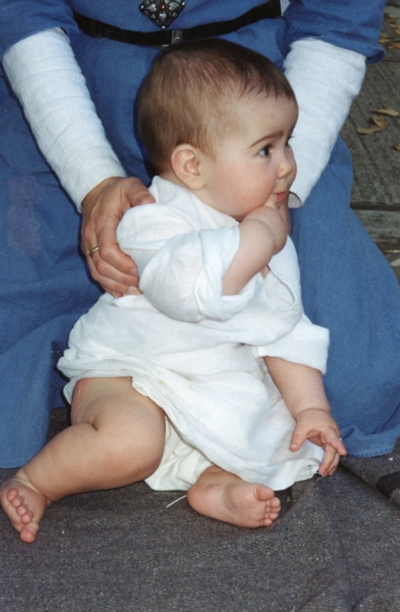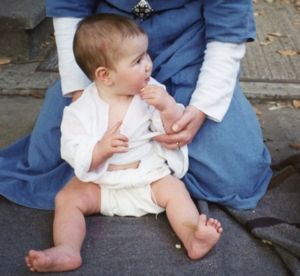
Historic
Recrudescence
Guild
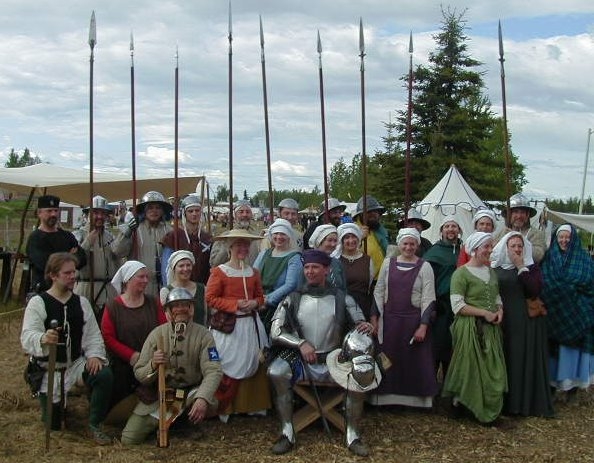
Lullay,
Litel Grom:
Baby Care in the Middle Ages and Renaissance
by Christina Ford, c2001
To Isabella,
without whom this never would have been written,
and in spite of whom it somehow was.
I saw a fair mayden sytten and sing.
She lulled a lyttel childe, a sweete lording.
Lullay myn liking, my dere sonne, my sweeting,
Lullay my dere herte, myn own dere derling.
(Anon. 15th Cent.)
Chemise | Tunic | Bibs
and Belts | Swaddling | The
Clout | Washing
Privy
Counselling, or The Water Closet Open'd | Feeding | Hair,
Hat and Shoes | Travelling | Cradles
Toys and Hansels| Simples and Other
Home Remedies | Yes,
They Did Do It, But... | Footnotes
Let's look at some examples of actual period practice, and then
apply them to the ultimate living historian's accessory – your
offspring.
The Chemise
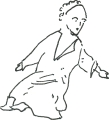 |
1. Chemise. Early 16th Cent. Flemish. Gerard David, Baptism of Christ. Sometimes gathered at the throat, sometimes smooth but with a slit down to about nipple height, very occasionally square-necked: the chemise varies greatly at the top but is nearly always ankle length. There is often a slit in front, at least to mid-thigh, which presumably helps with clout-changing. Chemises seem to be invariably white, and usually fairly flimsy. |
Knitted chemises
These are pretty rare in documentation. However, they show up in the mid-fourteenth century artwork known as the Knitting Madonnas. This is largely because these pictures portray Christ as a child, and various aspects of them refer to his adult life. In our period, it appears to have been a widely-held belief that the seamless shirt referred to in the story of the crucifixion (which was not divided up because it lacked seams, and so the soldiers cast lots for it) was a knitted shirt or chemise. There are a couple of extant shirts for adults, known by that time as waistcoats, from the early seventeenth century and plenty from the eighteenth century. Ignoring such niceties as damask-work (knitting pretty designs into the fabric by means of purl and plain stitches), the shape is pretty much that of a chemise, right down to the triangular neck gusset visible in the artwork of the Book of Kells. This shape has continued on into the modern era as the ultra-traditional guernsey pattern.
If you plan to knit a chemise, I would strongly suggest you use a guernsey pattern, but omit any ornament and make any other necessary adjustments (like ignoring the modern notion of knitting sleeves from the wrist to the shoulder and sewing them in place). I would also highly recommend using a fine wool, no thicker than sock wool. Baby wool would be ideal. This has to be worn under the day clothes, remember.
The basic shape is knitted in the round, from the 'hem' all the way to the shoulder; armholes are slashed (if you're brave enough – I never am, so I cheat and work the yokes flat) and the shoulders are created by casting off front and back together to create a narrow shoulder and wide straight neckline, while leaving the neck stitches on a holder until you are ready to knit that part. At the base of the armhole slash, pick up enough stitches, one at each end of every second row, until you have enough width for your underarm gusset, then pick up the rest of your stitches for the sleeve. Knit the sleeve from the shoulder to the wrist, but do not shape, as I have found no indication that knitters in the 14th century knew how to increase or decrease, or in fact to knit ribbing. Cast off. Pick up gussets in the shoulders the same way, to enlarge the opening for the neck. A modern guernsey would at this point have a ribbed neck; a period knitted chemise would not (see above), so you could in theory create a standing collar, but probably better is just to cast off with no collar, after making gussets.
1.
2. Such as those on the older children in Matsys, Appendix 4.vi.
3. Margaret Paston to John Paston I, letter no. 7, 1448, Paston Letters. The eldest of the 'childer' was at that time 6 years old. According to the glossary in my copy, frieze was a 'coarse woollen cloth'.

2. Bib. 16th Cent. Flemish. Matsys.
This item of clothing, called by Robert Herrick a ‘bib or stomacher’ (Opie p. 30) is a fairly rare occurrence, but is such a wonderful idea that I think it is well worth adopting. It is a waist-length rectangle with a semi-circular neck edge, just like a conventional modern bib. From the way it sits in the Matsys painting it is clear that it ties at the back, probably at waist level with cross-over straps from the neck, just like a pinafore apron. The bib acts not only as protection for the tunic front (which is useful as it is rather more frequently washable), but also as a belt, since belts do not seem to be worn by infants (who are generally waistless anyway). The belt function is particularly useful for crawling babies who are otherwise liable to attempt the feat of crawling up the inside of their own bodice, which is not good for anyone's temper.
Italian babies of the
Renaissance often have a cord around their waists, with a quick release ‘knot’ of
the loose end tucked partly through a slip knot to create
a small loop, and the
slip knot pulled tight.
There is a variation of this idea on each of the Vladimir
Madonnas: a wide piece of soft fabric is wrapped around the
waist to
serve as a belt. In some icons this waist-fabric has shoulder
straps
of the same material and width. The fabric is usually about
20cm/6” wide
and quite long. It is wrapped once around the waist, then
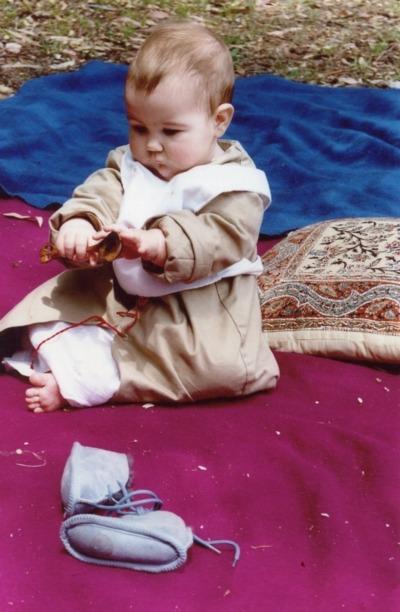 |
 |
 |
 |
| 3. Swaddling without bands. 14th Cent. Spanish. Golden Haggadah, Zipporah carrying two babies on way to Egypt. Fol. 10v. | 4. Swaddling with bands. 14th Cent. Spanish. Golden Haggadah, The finding of Moses. Fol. 9r. |
Until I started to look at period references to children for this research, I too subscribed to the general belief that swaddling clothes meant bandages. Now, I'm afraid, I have come to the conclusion that it was very different indeed. I have only found secondary evidence that swaddling was believed in period to straighten limbs, but I have little doubt that, if true tight bandaging were regularly practised, the shape of the limbs would indeed be distorted. After all, we are exhorted to vary the position in which a baby lies so that the head does not flatten on one side, and many of us know people who have some kind of bone distortion resulting from mishandling in early infancy (not to mention that the Masai deliberately shape their infants' heads to encourage a pronounced curve at the back). Why, then, is the evidence not stronger for limbs shaped by bandaging? It is probably because swaddling was actually very much like it is today – that is, wrapping an infant in a square piece of fabric, and presumably with much the same result of warmth and security. It would also have had the added advantage that it made a baby virtually immobile, which would ensure a certain amount of safety while sleeping. Swaddling is almost certainly what Mary is waiting to do with the cloth in the Lorenzetti picture (Appendix 4.vii). Incidentally, it seems that English is not the only language to confuse the two ideas, and to beguile the innocent into believing that our poor painstaking ancestors used bandages: the German word Windel appears to mean both swaddling clothes and nappy/diaper, and is claimed to come from the Old High German wintila, a thing to wind with, although an Old Saxon variant of the root word, biwindan, is defined as to wrap up (Kluge, p. 396).
It may be worth noting at this point that the bandaging of babies did exist, although as far as I can tell it was never called swaddling. A very few pictures, Italian for the most part, show babies bandaged from ankle to waist, over other clothes. Mantegna’s Presentation in the Temple (Bernard, page number unknown) shows the infant Christ in a chemise, with bandages over the top, but also wearing a little braided cap. My personal theory, although I have never found anything to confirm or deny on this point, is that this type of bandaging was occasionally used to provide comfort and safety during upright travel, for example in a basket (see Travelling).
Again, in some very few pictures, a naked infant is shown with a bandage wrapped around the waist only. This was almost certainly done to keep the remnant of the umbilical cord from getting caught in other clothing, as this practice continued even into the early 20th Century. Some people apparently also believed that bandaging prevented the navel from protruding later on, although there is no evidence that it had any effect on the matter, and in any case the practice is no longer believed to be useful.
Unfortunately, swaddling has multiple meanings, further clouding the issue. It is evident from Peter Erondelle's The French Garden (Appendix 2) that an older baby (his example is probably about 9 months old, judging by other details) at least was swaddled underneath his day clothes, suggesting that the term swaddling may have been used for two purposes: that of wrapping a small infant securely in a cloth over his day clothes, and that of wrapping a cloth for sanitary purposes around an infant's bottom, under his day clothes.
On examination of the available pictures of swaddled babies, a remarkable similarity is apparent. All of them have the cloth folded in the same way - in fact, all of them fold left side first and then right, from the point of view of the person doing the folding - although only some have swaddling bands (usually a cord) wrapped around in cross-garter fashion as well. It is not clear from the pictures how the band was secured. Possibly a quick-release knot was used, or possibly the ends were just tucked in tightly. It appears that the band starts and ends at the right shoulder of the child, rather than the foot. Interestingly, pictures almost invariably show the child being carried in the woman's left arm. Oddly enough, the folding technique is pretty much identical with the way many Muslim women fold their veils. My nurse in Israel tells me that there are also some cultural groups which still swaddle in exactly this method, although they are usually discouraged from doing so by the medical profession as they swaddle too tightly, which is considered to delay development and – far more importantly – court hypothermia as the child cannot move enough to get warm in cold weather. Perhaps the best thing the living historian could do is to apply the swaddling loosely enough for the child to move, and remove it as soon as practical.
Here is the method:
(Illustrations to follow: FIGURE 2.1-5 interspersed)
1. Lay the child on the cloth, a few inches down from the top, face up. Fold the top over so that the hem reaches to about the eyebrows (too much and the poor thing can't see; too little and the head loses its covering).
2. Fold left top corner down at a 90 angle, just meeting the side of the face.
3. Lay the whole of the left third of the cloth across the child, leaving the face uncovered.
4. Repeat 2 and 3 on the right side.
5. Bind using cross-gartering if desired.
Appendix 4.v and vi
 |
 |
| 1. Naked baby, held in clout with one point tucked into groin: 16th Cent., Grafenegg Chapel, Austria. | 2. 'Newborn' wearing clout. 16th Cent. German. Reichlich. |
I thought long and hard before deciding to commit this part of my research to paper, chiefly because there are several rumours rife among living historians and re-enactors regarding baby care, and who am I to buck tradition? The notion that infants did not wear clouts had me puzzled, as it left out of count some (to me) important factors: if the child wore bandages initially and then, when suitably potty-trained, graduated to skirts, what happened in between and for how long? I presume that children did not progress magically overnight from virtually immobile neonate to walking and reliably dry, since it still, sadly enough, doesn't happen that way; besides which, there are pictures of neonates in tunics. Some people have suggested that children simply wore nothing or very little until they had achieved bladder control (Deary, p.94). This works if the child is experiencing, say, summer in Venice, but you would very soon have an ill child on your hands if you tried it in a cold stone manor house in England, let alone further north. So what did people really do? We have already seen that many pictures of babies show them in tunics, chemises or other outer garb. Of the rest, only a tiny proportion – probably not more than a dozen in over 2 years of research - show them without a clout somewhere in the vicinity. Many pictures of a naked Christ Child have a folded clout underneath the child as he sits on Mary's lap. Clearly, Renaissance women were not so compliant as to sit for a painting without some form of protection! So why the lack of clothes in the first instance? It appears that there was a custom in our period to show the Christ Child naked, and thereby stress his humanity [2]. The clout itself seems to be about 2.5 to 3 feet (75-90 cm) square, sometimes more, very occasionally rectangular. It is invariably white (except for the Pienza cope where all clothes are a pale apricot), and usually looks remarkably similar to the cotton flannelette nappies/diapers commercially available today. Some clouts look like gauze, also still commercially available (in double thickness; these are the ones that tend to look rectangular in period pictures), though not so practical for any baby over 6 weeks old as they don't hold very much. The clout can be used for many purposes: over an adult's shoulder, on the child's bottom, as sheets for a cradle, as the swaddling layer for a newborn. A very few have lace edgings, which seems like madness, unless they were specifically used only for swaddling. They also seem to have been used as loincloths for pictures of the adult Christ, veils for lower-class women, and to hold a severed head in Dirk Bouts' Unfair Trial of Emperor Otto, but you don’t have to go that far. If you're packing for a camping event where there is plenty of water (and you can rely on it not raining the whole time), nothing could be simpler than to take a couple of dozen all-purpose cloths and some outer garments. There is no unsightly rubbish to contend with, no space taken up with single-use items, no catastrophes if you run out of disposables, no stepping out of period to attend to your baby.
When I wrote this originally, I elected to use the word 'clout' as a period alternative to the modern terms, since those terms we now use had a different meaning then. 'Clout' was at least used in period to mean 'cloth', so it seemed a reasonable choice until documentation uncovered a better one. Since that time, however, I have encountered records from the London Foundling Hospital, which show that babies did indeed wear clouts (and also pilches), in the eighteenth century at least. I therefore continue to use the word.
Although there are very few
pictures of a clout actually on a baby’s
bottom (so far I have only found two, and I have
been looking for several years)
5. Reichlich (Appendix
4.ii); perhaps the reason
there are so few pictures like this is that pictures
of the birth of Christ are much
more popular
than those
of the birth of either Mary or St. John the Baptist.,
there are enough for me to ascertain that the method
used is
still in use
in some
quarters today. It works thus:
(Illustrations to follow: FIG. 1, 1-6 interspersed)
1. Fold the clout in half, then in half again lengthways. Lay it on the changing surface, open edges down.
2. Open up the back of the clout, to about a third of the way down, by separating the two top corners.
3. Fold the back (top) horizontal edge underneath a couple of times, more if your baby is small and you want to use up cloth.
4. Place the baby on the clout with the crotch about a third of the way down. Pass lower, still-folded section between legs and up to tummy.
5. Bring the back corners around to front at waist and secure. If the child is very small, tuck the ends into each other. You may like to consider putting the clout on 'back to front' if the child is tiny and spends a lot of time on his/her back. It won't look so period but it will absorb more. If the infant prodigy is rather more mobile, tie the ends together in a reef knot if you can. For added security on a walking child, you could use a modern nappy/diaper pin if you think it necessary (I do).
6. Tuck the remaining folded part of the clout around and under the tied ends to secure.
The Clout Basket
In Gerard David's Rest on the Flight to Egypt (Fisher, pp. 67-8), there is a closed basket by Mary's feet. According to Fisher, this is a clout basket, going by other, unspecified pictures of open baskets containing rolled-up cloths. If a clout of the kind we have been discussing were folded in four as for Step 1 of the technique above, then rolled up and placed on its end, it should fit nicely into this depth of basket – and there would be one less step to do when the clout was needed. After taking a dirty clout off the child, shake the fæces off into the nearest privy, fold the open parts over any remaining, and roll up to store at the other end of the basket, preferably in a boilable cloth bag. I'd be tempted to separate the two sets of clouts further by putting any jars of ointment in between, and perhaps other equipment, such as olive oil, if you customarily use baby oil or lotion, and small (say 6"/15cm) squares of fabric for cleanups.
Since I've been talking about cloth clouts, I thought it would be sensible to dwell a little on getting them clean. This is actually not nearly as arduous as many people would like to believe. Put a pot of water on to boil, with some plain soap in it. When it is almost boiling, put some clouts in it, then put the lid on. Bring to the boil. Remove clouts (a smooth, clean stick helps), put the next lot in the same soapy water, which may need topping up. You get the idea. Rinse them all well and hang to dry. The clouts should move relatively freely in the water. I find that about 4 flannelette clouts work nicely in a 5-litre/quart pot. If the clouts are dirty rather than just wet, rinse as much solid matter off as possible, then boil for about 5 minutes. Do these after you have washed all the clouts which are merely wet. Hang in direct sunlight for a few hours if you can (but the boiling is enough on its own if you can't). This method bleaches and sanitises beautifully; I've never known a child dressed by this method to suffer from clout rash, and you can feel smug about Being Nice to the Environment at the same time. Just make sure the cloth is pure cotton or linen (or ramie, nettle or kudzu, if you’re making your own), because of the boiling process. In theory you should soak clouts as they accumulate: plain water for wet clouts, soapy water for dirty ones, in covered buckets for safety. In practice, if you wash every day or two (a good period activity for a campsite!) you need to soak only the rinsed dirty clouts if they have to wait before being washed. You can boil other clothes as well, if necessary, but do make sure that you don't boil synthetic fabrics (which you weren't going to use for either garb or baby clothes anyway, were you?), silk or wool (unless you want to end up with Barbie-sized garb). If you are using a strong colour at any stage, even for embroidery, check a sample for boil-fastness before risking the finished product. If it runs you'll just have to find some other way of sterilizing it, like plain sunshine. For some reason navy seems to be the most problematic colour I've found so far, although scarlet comes a close second.
Privy Counselling, or The Water Closet Open’d
Pictures
of the barely-walking age child seem to indicate that potty training was
practised at about this stage:
those male
children wearing
just the knitted under-shirt tend to be about this
age, and children both older and younger tend to
be fully
dressed. Personal experience
with the clout leads me to the conclusion that
this is the
ideal time for such things, as the clout is difficult
to keep on a
seriously mobile child unless you cheat and use
a pin. It is also about this
time that the child’s bladder starts to produce
more than the clout can absorb. Rien Poortvliet shows
a sort of miniature close-stool
in one picture, which, given the usual standard of
his work, is almost certainly documented somewhere,
although I haven’t seen it
yet.
(Tresoor (pub. in English as Daily Life in Holland) by Rien Poortvliet
in the Year 1566: and the Story of My Ancestor’s Treasure Chest)
Obviously, the most period thing you could feed a young baby is human
milk, whether yours or someone else's. Unfortunately, I know of only
one modern Western woman who has had the courage to breast-feed someone
else's children, so you might end up having to do it yourself (which
is not that bad, really). I won't go into all the modern physical
and social reasons why breastfeeding is a Good Thing; if you need
to know more contact your local Susu Mamas, La Leche League (ghastly
name), Nursing Mothers' Association or whatever your country is blessed
with. An additional advantage which they may omit to mention is that,
if your persona is Christian, she doesn't have to fast during Lent,
although if your baby decides to emulate St. Nicholas and refuse
the breast every fast day you rather lose the moral high ground.
6. There is the 11th century example (Appendix 4.viii) of a woman breastfeeding naked, although this only works if you are not subject to extensive and messy let-downs. There is also academic disagreement as to whether the woman depicted is aristocratic, bourgeoise or allegorical. That 'real' women did actually breastfeed is evident from the lifelike pictures of Mary feeding the Christ Child, and also from a marginal comment from a scribe: 'We possess one example from fourteenth-century Yemen of a Bible codex calligraphed by a woman. In the colophon the calligrapher, Miriam bat Benayahu Ha-Sofer (the Scribe), apologises that her work is of such poor quality, explaining that she was suckling a child while working' (Gerber, p. 155).
One of the most practical forms of garb for nursing is the kind that laces up the front (another is something voluminous with slits in the appropriate places – apparently Bedouin women still use nursing slits these days), or it would be if it weren't such a pain to lace and unlace every time your little angel starts howling. I don't know if Giovanna d'Aragona was feeding or not at the time she sat for da Vinci's portrait [18], but her bodice has a useful idea. Lace the bodice up to the bottom of the bust. Then, at the second-top holes or thereabouts, thread a ribbon through. Hers has a rosette of pearls at the end of each ribbon to stop it being pulled right through the hole. If you adopt this idea, make sure you use a large decorative button, or have your jewels firmly fixed to some kind of finding that is strong enough to keep the ribbons in place. Merely stitching a series of pearls to the end of a ribbon, as I did, results in a lap full of seed pearls and a gaping neckline. When you need to feed, you only have to undo the bow tying the ribbons, as long as your chemise has slits to feed through. The slits need to be about 4"/10 cm long, and directly over the nipple. If you whip-stitch the raw edges to secure them so that they don't fray, they are almost invisible. Some pictures show the breast exposed over the top of the bodice, but this needs to be done with care: if the bodice is cut too high, it can be extremely uncomfortable, and you run the risk of your neckline gaping for evermore.

7. Ribbon closure and nursing slits
The fact that many aristocratic women preferred to employ a wet-nurse may explain why there are so few pictures of babies from this period: if the artist was concerned primarily with well-heeled adults, tiny children may simply not have been present much of the time. This may also explain the dearth of explicit references to cloths for babies: dealing with them was what nurses and laundry-maids were for. Incidentally, Burton (p. 170) calculates that, according to what the nurse in Shakespeare's Romeo and Juliet (I iii 18-38) says about the day she began to wean Juliet, the child must have been suckled until she was three, although perhaps weaning with the use of wormwood (or, indeed, earthquakes) is something which should not be revived by living historians.
If you have to use formula, you could always try using a pap cup (see illustration. Note that in the line drawing I have deliberately omitted the second handle for visual clarity). The original (Speed, p. 46) was in pottery, which seems like an accident waiting to happen. Perhaps you could talk someone into making it from a nice, close-grained wood. Apparently they were often made from holly, partly for the grain and partly to ward off the evil eye (which amounts to the same thing when one's Lady Mother is surveying a split cup or bowl that has been dropped too many times on a stone floor…). It is probably wise to get your child accustomed to any utensils at home before using them at an event. Novelty is all very well in its way, but one doesn't want to eat from it. If you feed your Heir pap at an event, I would strongly suggest making it from rice flour or oatmeal – or, in fact, anything except semolina or polenta - as these are the least tiresome to clean up afterwards. When you start to serve 'grown-up' food, don't avoid the funny-tasting period ones: rosewater is no weirder than vanilla to a new eater, and ground grains of paradise no harder to deal with than ground cinnamon, and you'll save yourself a few battles at events later on.
7. Pap is usually porridge or other cooked cereal. In Gerard David's painting (Appendix 4.iv) it is fed with a spoon from a bowl, but evidently it could sometimes be rather more liquid. Apparently, motherless children were fed pap from a very young age, if a nurse could not be found for them, which may explain the other meaning of the word, which is 'breast' (see Appendix 1). Pap was also fed to the old (and presumably by extrapolation to anyone else with difficulty chewing), according to the poem 'Pap ende Broodt in Doude Daghen', by Anthonis de Roovere (Bruges, d. 1482; Gijsen, p. 139, English translation of title, 'Pap and Bread in the Old Days').
If you don’t have (or want) access to a pap cup, apparently some people (presumably the poorer end of society) used a funnel made from a cow’s horn with the tip cut off – though I sincerely hope they didn’t afterwards feed the baby with the funnel used to put Edward II to death.
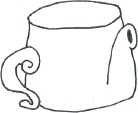
8. Pap cup (Speed 1987, p. 49). Note that in redrawing I have deliberately omitted the second handle for visual clarity.
It seems that neither hats nor shoes were used for babies not yet walking, although the baby in Mantegna’s Presentation in the Temple, who is presumably dressed for travelling (see Swaddling), does wear a braided cap. It is made from a single piece of fabric, roughly the shape of an orange-skin quarter (or perhaps sixth), and gathered along one long edge, to form a back. The strings which tie under the chin are passed behind the ears. The very young child – just learning to walk, by the look of it - in the Waddesdon Manor MS wears shoes and what appears to be a red coif. My guess is that these items of clothing were used as a carrot to encourage the baby to attain the next stage of development. When your child is ready for shoes, by all means make them appropriate to your chosen period, but don't forget to give them a flexible, non-slip sole, such as suède.
Although I have found no documentation to prove this one way or the other, I cannot help noticing the preponderance of pictures which show babies with curly hair, and wondering if perhaps there was a fashion in the Renaissance for curling babies' hair around the fingers as it dried. A moderately wavy-haired child can have the curls encouraged by 'combing' wet hair with the fingers, against the direction of growth, which may even have been the original idea, saving the use of a comb until the child is older and more able to endure it. Children less prone to wavy hair could have their hair dampened with a mucilage of linseeds first, as a kind of setting lotion.
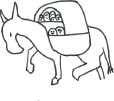
9. Baby-carrying panniers on donkey. 15th Cent. German/Italian. Ashkenazi Haggadah.
Who was the clever person who first made the observation that living in a mediæval manor house was much the same as camping anyway? If you have a basket for clean clouts, a bucket for dirty ones, perhaps a tub to wash them and the infant (rinse the tub out with boiling water before you put the sprog in there), and a cradle (see next section), what more do you need? Most pictures of travellers show the woman carrying the infant in her arms as she rode. There are, however, a couple of notable exceptions. One is the wholesale-baby-pannier setup on the back of donkey in the Ashkenazi Haggadah; another is a 15th Cent. German woodcut [22], which shows the baby strapped into its cradle with a rope which zigzags across from the neck downwards. The cradle is then slung onto the poor horse along with the mother and all the household equipment. There is also Vecellio's woodcut of a 'woman of the [Scandinavian] northern regions' carrying her offspring in a basket (made of woven strips of wood, by the looks of it) on her back [23]. This type of upright travel must have been fairly detrimental, or at least uncomfortable, to the legs of small babies; perhaps this is where the bandaging theory (see Swaddling) actually has a place.
For carrying around a large encampment,
probably this last option is the most practical, although I imagine
that period practice
usually entailed passing the bundle around from admiring female
to admiring
female until it fell asleep, whereupon it could be tucked up
in a cloak and put safely in a corner somewhere. Young men
can usually
be bribed to help carry infants with the offer of garb or food;
teenagers
of both sexes may well hold out for hard cash. If no help is
forthcoming (in a courteous group like ours?), you could try
carrying a small
baby in a large, flat basket. Although I have no documentation
for this, it would look a great deal better than mundane baby
equipment.
While on the topic of camping, don't forget to baby-proof your
pavilion area as much as possible if your little monster is
mobile: sharp implements, including
loose tent-pegs, could be kept in a basket and suspended somewhere; lamps
and candles kept out of reach; firepits fenced off (what about
a wattle hurdle?);
your baby and your pavilion both decorated with your device; and so on.
Look at your encampment, and the neighbours', from knee-level
and act accordingly.

10. Cradle.
16th Cent. Spanish. Juan de Borgoña.
One can see quite clearly from the available evidence that babies of our period commonly slept in cradles, and even sometimes travelled in them. The pictures tend to show the mattress reaching almost to the top of the cradle, which could allow the baby to roll out if not securely swaddled and tucked in, although this may be artistic licence to allow us to see in the cradle. Perhaps the modern living historian would be better advised in this instance to provide less padding and more 'wall' – preferably fairly open to allow air - for safety's sake. What was done with the child after it grew out of the cradle is less clear: as people generally shared beds, putting the baby between two older children (until he/she acquired the skill of not falling out) seems most likely. The word crib seems to have been used exclusively for an animal’s manger at this time (e.g. Wakefield Second Shepherds’ Pageant, line 689. Cawley, p. 106).
Going by early 20th century records as well as period ones, a baby's cradle probably would have had two mattresses: the lower one a palliasse filled with hay or straw (I understand that things have turned full circle and that Australians can now buy mattresses stuffed with ti-tree bark), which was opened and the stuffing renewed fairly regularly; and the upper one being more a quilted pad stuffed with cotton or woollen wadding, often made from cleaned dags and other bits that are difficult to spin. There would be more than one of these, so that they could be washed as often as necessary. Sometimes a sheepskin would be laid on top of the pad, under the sheet, but this is not recommended any longer unless you have access to sheepskins that have been neither dipped nor tanned in toxic chemicals. In the relatively recent days when skins were used regularly, more than one would be owned so that these, too, could be washed frequently. The skin would prevent too much seepage and so have the advantage that the pad and mattress would need less frequent attention. The living historian who does not have access to safe skins would probably be better advised to put a rubber sheet under the pad and change the pad frequently. Do please make sure, for safety's sake, that the pad is firm and your baby can't work his/her head into a hollow and smother. Also, for fire retardency, try to use wool ahead of cotton or bark.
Other bedding is relatively simple, as one uses the ubiquitous 'clout' for sheets, no pillow (although they were used in period, they are no longer recommended for young babies, except as something pretty which you remove before putting the infant to bed) and blankets, preferably of a loose woollen cloth, which has always been recommended as the safest warm covering for a child, as breathing is less likely to be obstructed if the baby gets his/her head covered.
 |
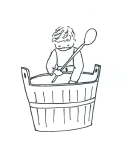 |
|
Incised bone heads for rag dolls, c. 8th Cent., Iran and Holy Land. |
Fortunately this age doesn't need many real toys, so you have time to research them for your time and place before they become necessary. Something to chew on for teething (my daughter has a wicker ring which looks marvellous and which she loves) might prove useful, and well-off Elizabethan children knew the joys of rattles, (Marten de Vos; Appendix 4.xi), although to be honest, this looks like a distinctly unsafe piece of equipment: too many loose bells to break off and swallow, and to my mind coral is too brittle to use for a teether (note that it is still in the 'lucky' horn shape visible in earlier amulets). Other than that, babies don't seem to have had many specifically baby-oriented toys. As the age we are discussing loves examining grown-ups' things, perhaps the best thing to do is make sure you have some period items with you that you are prepared to share, and which conform to modern safety standards for infants. According to Eisenberg et al., pp 253-4, safety features for toys should include:
a) Sturdiness – toy should not break or fall apart easily.
b) Safe finish – paint or other finish should not be toxic. [In the context of living history this means making sure you don't give the infant pewter, brass or copper to suck, as well as checking for lead in paint – or toxic ochres, for that matter. CJF]
c) Safe construction – avoid things with small pieces, sharp edges or breakable parts.
d) Washability – to ensure cleanness.
e) Safe size – toy should not be (or have breakable/removable parts) less than 1.5 cm/_" in diameter so it cannot be a choking hazard.
f) No strings attached – toy should not have strings, ribbons or cords longer than 15cm/6" so it cannot garrotte your infant.
g) Safe sound – if the toy makes a sound that is too harsh and loud, it may damage hearing (as a basic rule of thumb, if you have to raise your voice to be heard over it, it's too loud – ibid, p. 159).A toy which might suit an older baby or small child (or adult…) is a totum, or 'foursided disk made for a spinning toy, with a letter inscribed on each side: T (totum - all), A (aufer - take), D (depone – put down), N (nihil - nothing). The player's fortune was set by the letter uppermost when the toy fell' J. Kinsley (no title given), 1958, Oxford, England, and William Dunbar (c.1460 – c.1513) 'To the King' in J. and W. MacQueen. 1972. A Choice of Scottish Verse 1470-1570, pp. 114, 199. Faber and Faber, London, England. Going by the modern use of the Chanukah dreidel, there would be a pile of money, comfits, or whatever in the middle of the players, and the player who spins the totum would be expected to do something along the lines of: (T) take all of it; (A) share the pile with all the other players, perhaps one piece each; (D) add a piece from his own stash to the pile; or (N) do nothing for that turn.
Among other toys, Burton cites Hugh Plat's innovation of alphabet blocks, although the original text seems somewhat elusive on this point (most authorities who refer to him seem to be interested only in food), and rag dolls were also known and used in at least some areas and times of our period (sometimes using bone heads with incised features as above; see also Appendix 4xi). Hansels were gifts that were given on the arrival of something new (usually the New Year, but also to a new baby). The shepherds in the Wakefield Second Shepherds’ Pageant (Townley Cycle) bring ‘a bob of cherries’, a bird and a ball. Robert Herrick, who was born in the 16th Century but wrote mostly in the 17th, speaks of a flower, coral (to ward off evil) and a ‘whistle new, made of a clean oaten reed’ (Opie, p 30).
Simples and other Home Remedies
Colic
"
A decoction made of camomile, and drank, takes away all pains… the bathing
with a decoction of Camomile takes away weariness, eases pains… it eases
all pains of the cholic." (Culpeper)
Chamomile (preferably Matricaria recutita, German chamomile) is a traditional
remedy for calming babies. Tea, made from 1 tsp dried chamomile flowers to
a cup of water and then diluted with an equal part of water when cold, can
be fed to a teething or otherwise restless infant. You don't ever need to
use a bottle for this: a teaspoon or cup is quite adequate if you hold the
baby
on your lap. Chamomile can also be added to the bath of a colicky baby.
Engorgement
"
Comfrey … a decoction of the leaves hereof is available to all the purposes… it
is good to be applied to women's breasts that grow sore by the abundance of
milk coming into them." (Culpeper)
Comfrey oil is still sometimes recommended as a soothing
treatment for sore breasts, although for engorgement
the more usual modern version is to apply
cold, raw cabbage leaves (don't use them too long, as
they tend to reduce the milk supply).
Eye Infections
Some cultures use chamomile to treat eye infections (make sure it's fresh
and therefore sterile!), although extensive personal observation
indicates that
breast milk is much much better, and a traditional remedy
in many other cultures – put
a few drops in the eye whenever necessary/possible and wipe up any residue.
Cradle Cap
Rash
"
Comfrey… for outward wounds or sores in the fleshy or sinewy part
of the body whatsoever… a decoction of the leaves hereof is available
to all the purposes… it is good to be applied to women's breasts
that grow sore by the abundance of milk coming into them."
Oil infused with comfrey (Symphytum officinale) is excellent for healing all sorts of minor skin problems, like cradle cap, although Romain and Hawkey say not to use it on nappy rash if the rash is infected, as the skin may heal so fast the infection could be sealed inside. You can make the oil by filling a jar with comfrey leaves and covering them with oil, closing the lid and leaving the jar in a sunny place for a month (shake periodically). Alternatively, you can heat 250g (8oz) dried leaves with 600ml (1 pint) vegetable oil very gently in a bowl over simmering water (hereafter called a bain-marie) for three hours. Strain either kind of oil through cheesecloth and store in a dark bottle in a cool place. If you are worried about the oil splashing around and ruining your clout basket, you could make an ointment instead: heat the infused oil (made as above) in a bain-marie and add a .5"/1cm cube of beeswax. Stir until melted, let cool a little and pour into a dark jar. All these preparations should be good for about a year.
" The juice of Marigold [petals] mixed with vinegar, and any hot swelling bathed with it, instantly gives ease, and assuages it."Marigold (Calendula officinalis) petals can be made into an oil in the same way as comfrey. It is gentle and soothing to the skin. No mention is made these days of mixing it with vinegar, which is probably a bit harsh for a baby's skin anyway. Marigold can also be used on the nipples if they are sore from breast-feeding, although many mothers are now advised to use their own milk for this.
" Red Roses… mitigate the pains that arise from heat, assuage inflammations, procure rest and sleep."
Mmm. Rose tea in the bath! This doesn't seem to get much press any more, except from aromatherapists, but rose petal tea – or, in fact, distilled rosewater, to save you making it when you're in a hurry, though it might pay to make your own so you know it has neither alcohol nor (ack!) sugar - would make a wonderful wash for a sore bottom (so, in fact, would marigold tea), as it is both gentle and soothing.
Wind
"
Fennel is good to break wind… the leaves or seed, boiled in barley
water and drank are good for nurses, to increase their milk, and make it
more wholesome
for the child."
Fennel (Foeniculum vulgare) tea is excellent for babies
suffering from wind. Make a tea using half a teaspoon
of seed per cup of water. Let stand for
10 minutes and dilute with an equal quantity of water
before using. Fennel is
still considered to aid the production of breast milk,
and also to pass through the milk, which helps reduce
colic in that way. Make tea if you want to drink
it (1 tsp seed per cup water), or barley water (soak
a tablespoon of barley - and the fennel - in a cup of
boiling
water, sweeten if desired, and leave
to get cold before straining), or cook with it. It should
all have the same effect.
Yes, they did do it in period but…
Coral. Apparently popular for warding off the evil eye
in the Renaissance (Fisher, p. 103; Appendix 4.xiii), but the reefs have
enough
trouble as it is without
our encouraging further plunder. What about hanging some garlic around
the little dear's neck instead?
Honey. This is currently considered inappropriate for
children under 1 year of age, because it can harbour spores of Clostridium
botulinum
(i.e. the bacteria
which causes botulism) – in this form harmless to adults but not
to infants (Eisenberg et al., p. 262).
Lead in food utensils (such as pewter). Aargh. If you
want to keep your child, please stick to wood or a noble metal.
Names. Héloïse may have named her son Astrolabe
(Abelard, p. 69), but she was acting under the influence of Peter Abelard,
who among other things
had convinced her that philosophy students having affairs with their
lecturers were exempt from normal social conventions. If your infant
hasn't already got
a name, perhaps you might consider a documentable one. It can be disconcerting,
when all around are speaking good Shakespearean English, to hear a fond
mother calling out to little Moon Unit. There are plenty of bizarre names,
if
that's
your preference,
from within period.
Walkers. These wheeled frames are banned in several countries,
because they don't just interfere with normal physical development, they
are also downright
dangerous (Stammers, p. 196).
Wormwood for weaning. Bad idea. Even adults' digestive
systems are too young for this stuff.
8. (Royal Museum of Fine
Arts, Brussels, Belgium, Bois H.3.24 L.I.82; Ruwière, p. 53).
9. Appendix
4.iii.
10. See footnote 5.
11. Appendix
4.v.
12. Erondelle (Appendix 2); Marten de Vos (Appendix
4.xi).
13. Baggio, p. 123.
14. Appendix 4.vi
15. Appendix 4.ix
16. Appendix 4.ix
17. Published 1652. http://www.bibliomania.com/NonFiction/Culpeper/Herbal/
18. Romain and Hawkey; McIntyre; and a very helpful early childhood nurse
who advises me.
19. Speed 1987, p. 46.
Home | Events | Research and Experiments | HRG in the Schools | Links | Email us:hrg@gci.net
